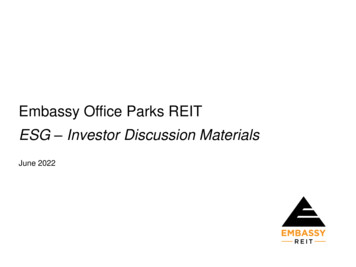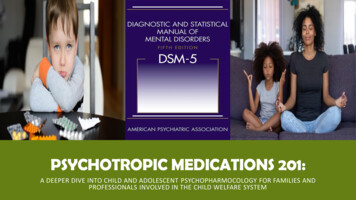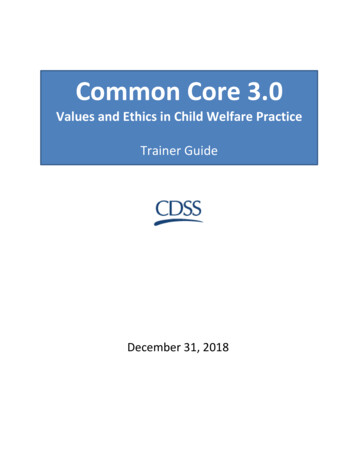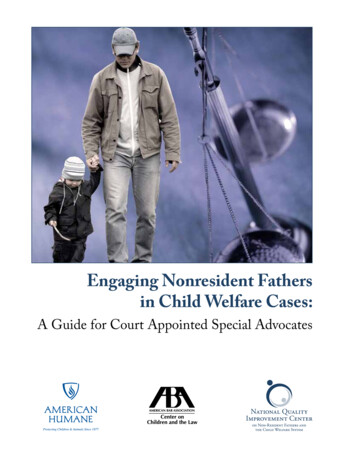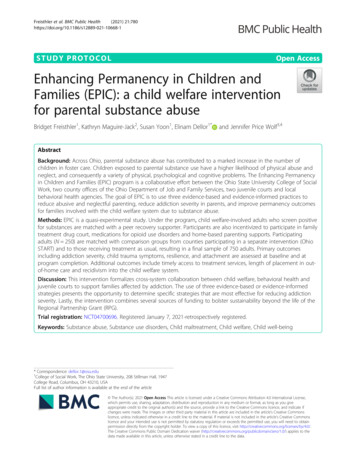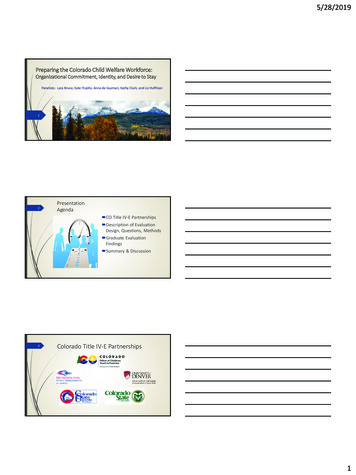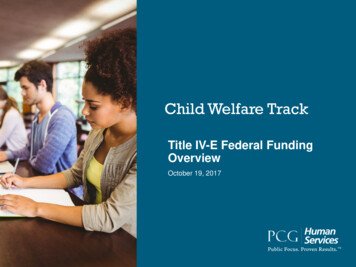
Transcription
Child Welfare TrackTitle IV-E Federal FundingOverviewOctober 19, 2017
Agenda Introduction Understanding Title IV-E Title IV-E Training Understanding Key Terms Title IV-E Stipend Programs Managing Riskswww.pcghumanservices.com Title IV-E Funding Overview2
IntroductionsKay CaseySr. Advisorkcasey@pcgus.com(850) 329-4902Katie BrightAssociate Managerkbright@pcgus.com(312) 253-3725Kate SmithConsultantkatsmith@pcgus.com(317) 829-6555www.pcghumanservices.com Title IV-E Funding Overview3
Understanding Title IV-E
Title IV-E The complexity of Title IV-E is realized when it comes to claiming trainingreimbursement more than in other federal programs Does the training align closely to an administrative cost?What costs are allowed or not allowed? Who can be claimed?How do we match costs?Which eligibility rate (foster care, guardianship assistance or adoption assistance) shouldbe used? What is the eligibility rate ? Adding to the complexity is how Title IV-E is reimbursed: Maintenance costs at the Federal Medicaid Assistance PercentageAdministration costs at 50% Federal Financial ParticipationTraining costs at 75% Federal Financial Participation Costs may be claimed by the State or Tribal child welfare agencywww.pcghumanservices.com Title IV-E Funding Overview5
Maintenance Costs child is eligible for Title IV-E when a number of eligibility requirements aremet. The costs associated with the room, board, care and supervision ofchildren in licensed out-of-home placements are claimable to Title IV-E. Costs directly to foster parents, child caring institutions, shelters andgroup homes Eligibility for maintenance is critical piece of any administration ortraining claiming.www.pcghumanservices.com Title IV-E Funding Overview6
Administration costs Covers a broad array of costs necessary for the proper and efficient administrationof the Title IV-E State Plan 45 CFR 1356.60 ( c) describes the allowable administrative activities as:Referral to services;Preparation for and participation in judicial determinations;Placement of the child;Development of the case plan;Case reviews;Case management and supervision;Recruitment and licensing of foster homes and institutions;Rate settings;Costs related to data collection and reporting; andA proportionate share of related agency overhead The salaries, fringe, benefits, and operating expenses of all personnel performingthe above named activity or an activity closely related to the activity isreimbursable.www.pcghumanservices.com Title IV-E Funding Overview7
Training Covers training that is closely aligned to the allowable Title IV-E administrativeactivities and that are necessary for the proper and efficient administration of theTitle IV-E State Plan Who can be trained? State employees through pre-service and in-serviceFoster parents, adoptive parents and guardians (under Guardian Assistance Program),child caring institution staffJudges and other members of the staff of abuse and neglect courts involved in makingjudicial determinations and other decisions regarding families in the child welfare systemContracted personnel who are performing tasks to support the child welfare agencyAttorneys representing the state agency, the children or their parents (CWPM, 8.1H,Question 20) Training courses, audience, and distribution of costs must be recorded in Childand Family Services Five Year Plan and updated in Annual Services Plan Update(Title IV-B State Plan) Training costs and the allocation methodology must be incorporated in theState/Tribe Cost Allocation Planwww.pcghumanservices.com Title IV-E Funding Overview8
Title IV-E Training
What is allowable? Confusion often emerges when state agencies/universities begin to unravel whatcosts are attributable to training (at 75%), administration (at 50%) or unallowable(at 0%). What topics are not allowed for Title IV-E reimbursement? How to address or treat child or family problems or behaviors because it supports thedelivery of social services rather than the administration of the title IV-E State plan. Conducting child abuse and neglect investigations because such specialized skills arerequired for staff activities that occur prior to a child entering foster care or adoption, andeven prior to a child becoming a candidate for foster care. Child welfare/social service topics that are not related directly to the Title IV-E programsor the administration of the Title IV-E State plan. What training is allowed at 50%? State agency personnel policies and procedures Job performance enhancement skills (e.g., writing, basic computer skills, timemanagement) First aid, CPR, or facility security training General supervisory skills or other generic skills needed to perform specific jobs Ethics unrelated to the Title IV-E State plan Team building and stress management training Safe driving Worker retention and worker safetywww.pcghumanservices.com Title IV-E Funding Overview10
What is allowable? What topics are allowed at 75% FFP? Federal guidance indicates that to be claimed at 75% the training must be for theadministrative costs identified or the costs are necessary for the proper and efficientadministration of the Title IV-E State Plan. The Child Welfare Policy Manual (CWPM) has an extensive list of allowable trainingtopics. (CWPM, 8.1H, Title IV-E, Administrative Functions/Costs, Training) Topics suchas: Communication skills for working with children and families. Social work practice, such as family centered practice and social work methodsincluding interviewing and assessment. Cultural competency related to children and families. Title IV-E policies and procedures. Child abuse and neglect issues, such as the impact of child abuse and neglect on achild, and general overviews of the issues involved in child abuse and neglectinvestigations, if the training is not related to how to conduct an investigation ofchild abuse and neglect. Permanency planning including using kinship care as a resource for childreninvolved with the child welfare system. General substance abuse, domestic violence, and mental health issues related tochildren and families in the child welfare system, if the training is not related toproviding treatment or services. Effects of separation, grief and loss, child development, and visitation.www.pcghumanservices.com Title IV-E Funding Overview11
Training CostsTraining Costs Allowable at 75%(45 CFR 235.64)For Agency Training SessionsCostsEmployees in initial in-service training for atleast a weekSalaries, fringe benefits, travel and perdiemTrainees in short-term and/or continuingtraining sessions away from the work site, ininstitutes, seminars, workshops related tojobSalaries, fringe benefits, travel, per diem,tuition, books and registration feesExperts from outside the agency engaged todevelop or conduct special program onrelated to child welfareSalaries, fringe benefits, travel and perdiemDevelopment CostsCosts of space, postage, teaching supplies, purchase or development of teaching materialand equipment, and the cost of maintaining and operating a training library as an essentialresource to the training program.www.pcghumanservices.com Title IV-E Funding Overview12
Training Costs (Cont’d)Training Costs Allowable at 75%(45 CFR 235.64)For Training Away from the AgencyCostsFor employees with no assigned dutiesparticipating in full-time, long-term trainingSalaries, fringe benefits, dependencyallowance, travel, tuition, books andeducational suppliesFor employees in full-time, short-term trainingSalaries, fringe benefits, travel, tuition, books,and educational suppliesFor employees in short-term training programsof less than 4 weeks on part-time trainingprogramTravel, per diem, tuition, books and educationalsuppliesFor persons preparing for employment with thestate or local agencyStipends, travel, tuition, books, and educationalsuppliesEducational ProgramsFFP for payments to educational institutions as described in 325.63(c) to include salaries, fringebenefits, travel of instructors, clerical assistance, teaching materials and equipmentwww.pcghumanservices.com Title IV-E Funding Overview13
Key Terms
Understanding Key TermsFFP – www.pcghumanservices.com Title IV-E Funding OverviewCPE – CertifiedPublic ExpenditureEligibility Rate15
Understanding Key TermsFederal Financial Participation (FFP)www.pcghumanservices.com Title IV-E Funding Overview16
Understanding Key TermsAllocation Methodologywww.pcghumanservices.com Title IV-E Funding Overview17
Understanding Key TermsCertified Public Expenditure (CPE)www.pcghumanservices.com Title IV-E Funding Overview18
Understanding Key TermsEligibility Rate Ratio of children who are Title IV-E eligible to the total population ofchildren in out of home care Calculated quarterlywww.pcghumanservices.com Title IV-E Funding Overview19
Title IV-E Stipend Programs
Title IV-E Training & Stipend Programswww.pcghumanservices.com Title IV-E Funding Overview21
Audit Risks – DAB Decisions
Audit Risks – DAB DecisionsIllinois Department of Children and Family Services, DAB No. 1422 (1993) Issue: Untimely Claiming Finding: A claim for FFP for expenditures under Title IV-E are required to befiled within the two-year period which begins on the first day of the quarterfollowing the quarter in which the expenditures were made. ACF disallowed part of the direct training costs claimed by Illinois on theground that these costs should have been allocated to benefittingprograms other than Title IV-E. ACF also disallowed all of the indirectcosts which Illinois claimed on the ground that the indirect cost rateswhich Illinois applied to calculate these costs were developed usingcosts that were not allowable as training costs.Florida Department of Children and Families, DAB No. 2080 (2007) Issue: FFP for Title IV-E training costs is not available for training persons foremployment at private agencies. Finding: FFP at the 75% rate for Title IV-E training costs is not available fortraining persons who will be employed in private agencies.www.pcghumanservices.com Title IV-E Funding Overview23
Audit Risks (con’t)Nebraska Health and Human Services System, DAB No. 2110 (2007) Issue: Whether Nebraska can allocate to Title IV-E all of the costs of foster caretraining for child protection and safety workers who are employed by or preparing foremployment with Nebraska, even though those workers also handle cases of fostercare children who are not eligible for Title IV-E maintenance payments. Finding: The HHS Division of cost Allocation (DCA) has discretion to disapprove astate’s proposal to charge costs to a program even if the program agency would allowit, but DCA must give an adequate reason for why it does not defer to agency policy.New Mexico Children, Youth and Families Department, DAB No. 2159 (2008) Issue: Whether all indirect costs can be claimed at 75% FFP. Finding: Indirect administrative costs must be claimed at 50% FFP.West Virginia Department of Health and Human Resources, DAB No. 2529 (2013) Issue: CAP Methodology Finding: CAPs must include an acceptable methodology for allocating claimedtraining costs.www.pcghumanservices.com Title IV-E Funding Overview24
www.publicconsultinggroup.com
required for staff activities that occur prior to a child entering foster care or adoption, and even prior to a child becoming a candidate for foster care. Child welfare/social service topics that are not related directly to the Title IV -E programs or the administration of the Title IV -E State plan. What training is allowed at 50%?
